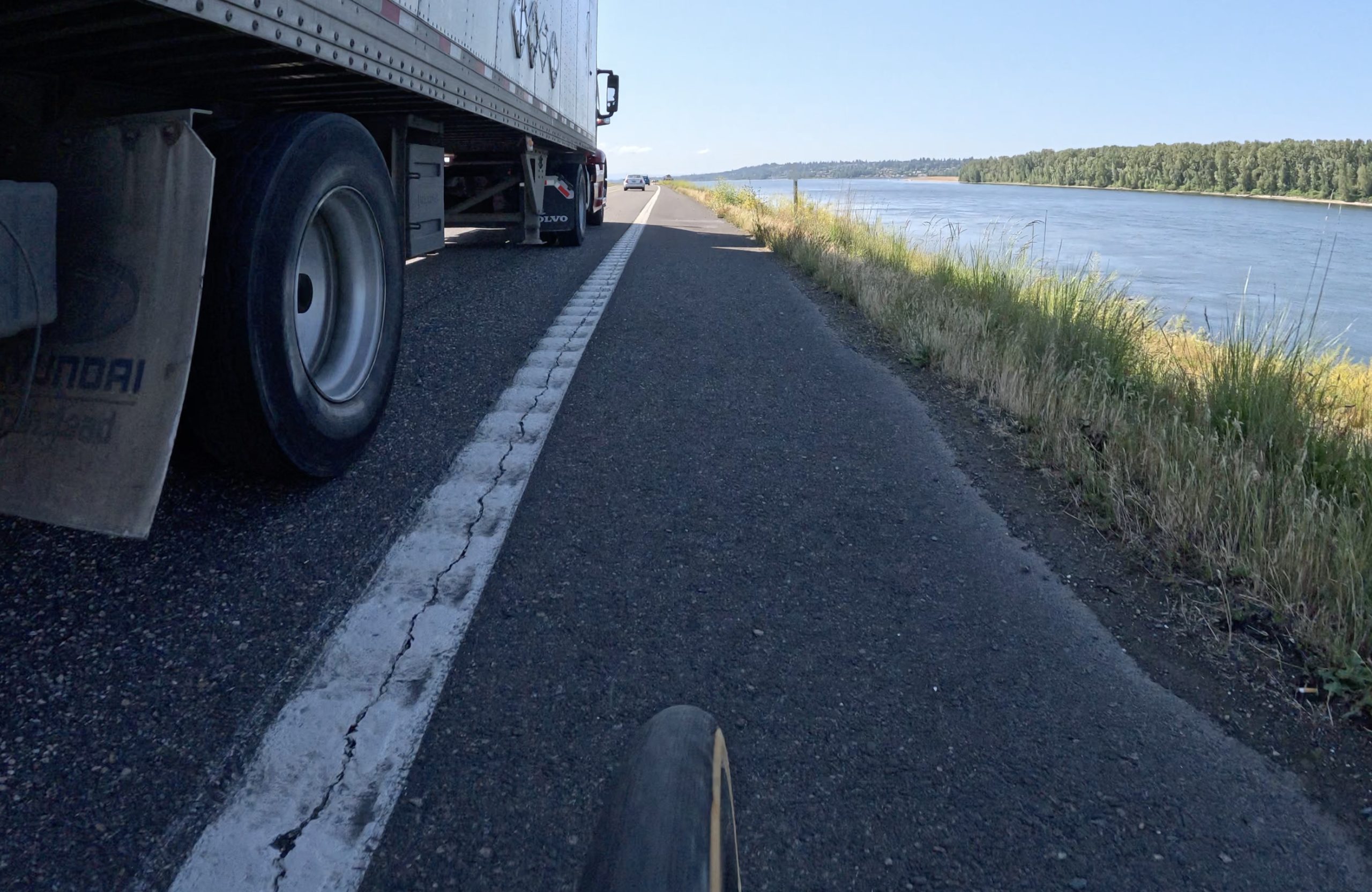Dangerous close pass on Marine Drive captured on video – BikePortland
Portlander Chris Ho was cycling on Northeast Marine Drive this week when the driver of a large freight truck passed him very closely. Chris shared the video online and it has spurred conversation and confusion about Oregon passing laws and road user choices. I want to elevate the incident because this is an important issue that deserves clarity and understanding.
Chris is an experienced bicycle rider. He’s a veteran volunteer in local bicycle advocacy circles, a regular at Bike Happy Hour, a collector of road bikes, and a participant at local races. On Wednesday around 4:00 pm he was cycling westbound on Northeast Marine Drive about 1.5 miles west of I-205 and adjacent to Portland Airport runways. There are two route options for bicycle riders at this location: there’s a dedicated, off-street path along the Columbia River and a shoulder on the main road. Chris was (obviously) riding on the shoulder.
As Chris pedaled on a clear and sunny day, the truck driver whizzed past, just inches away from his body and bicycle. The pass was so close it created air suction effect that threw off Chris’s trajectory, and pulled his bicycle even closer to the big rig. (This is a well-known effect that has led to many fatal bicycle crashes over the years — even if police reports often fail to take it into account and instead blame the bicycle rider for “falling into” the truck operator’s path.) “This was a very close call, and super scary!” Chris shared in a post on his Instagram. Chris’s video captured the truck driver’s license plate number and he’s considering pursuing charges.
When I shared Chris’s video on BikePortland’s social media, I heard two main responses that stood out to me: some folks didn’t think the truck driver did anything wrong, and others wondered why Chris was even on the road in the first place (and not the path).
First let’s talk about the pass itself. Chris was in a legal cycling position, riding on what’s technically known as a shoulder bikeway. It’s not a “bicycle lane” as defined in Oregon law. The way we can tell the difference is by the width of the white stripe and the absence of bicycle lane markings and signage. (The distinction between a shoulder and a bike lane matters because different laws apply in each situation.)
The speed limit in this location is 40 mph and it’s a “no passing” zone. Given all those conditions, the truck driver clearly made an illegal pass. Oregon Revised Statute 811.065 states that motor vehicle operators must pass bicycle riders at a “safe distance” which is defined as a distance that is, “sufficient to prevent contact with the person operating the bicycle if the person were to fall into the driver’s lane of traffic.” Based on Chris’s video, that provision of the law was broken. The passing law was expanded in 2023 to require that drivers slow to at least five miles under the posted speed limit and to clarify that they can move over across a double yellow line in order to complete the safe pass.
After the law went into effect in 2024, the Oregon Department of Transportation made a PSA video that includes an example of a pass that closely resembles this situation.
For folks who think Chris should have been cycling on the adjacent path, keep in mind that not all bicycle riders are the same and people are allowed to choose where they ride. And in this case, not only was it entirely legal for Chris to be on the shoulder (which is classified as a “City Bikeway” in our Transportation System Plan), but the path option isn’t as attractive as you might think. This part of Marine Drive has a reputation for people pitching tents along the path. Public safety concerns get exacerbated here because the path is far below the street, which means it lacks visibility. Many riders also don’t like taking the path because it requires them to criss-cross Marine Drive at several locations and they feel these crossings are more hazardous that just riding on the shoulder. For fast, road cyclists, off-street paths can also be less desirable because they often have uneven surfaces, bumps and cracks that make for an unpleasant ride.
Dangerous and illegal passes like this are way too common. They are a symptom of our dysfunctional road user culture and illustrate the blatant disregard for human life far too many people have when they get behind the wheel of a motor vehicle.
I hope this post helps add context to this dangerous incident. And I’m very glad that Chris was not injured or worse.
For anyone who drives on Marine Drive, please slow down and pass bicycle riders with the utmost caution. And remember, “This isn’t some sort of video game!” as Chris shared on Instagram Thursday. “I could have very easily died today.”
Share this content:
















Post Comment